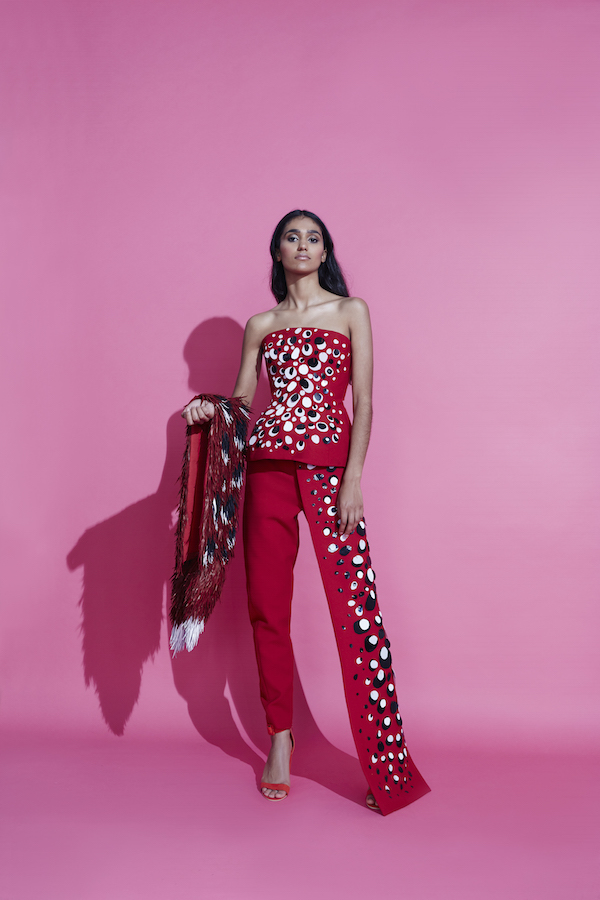Next gen designers: Sarah Hope Schofield
Cream of the crop.
With the arrival of Virgin Australia Melbourne Fashion Festival, it’s time you got to know more about this year’s graduate designer lineup.
These designers are the crème de la crème of the country’s top tertiary institutions, all brought together as part of the National Graduate Showcase.
Presented by AMP Capital and supported by Fashion Journal, the National Graduate Showcase will take place at the Royal Exhibition Building on March 19. You can pick up a ticket here.
Once specialising in accessory design, RMIT graduate Sarah Hope Schofield has worked with the likes of Dior, Louis Vuitton, Jacquemus, Nina Ricci and Versace. She’s also established her own streetwear label, ASSK, stocked at over 30 global retailers and sported by the likes of Rihanna.
After returning to Melbourne to complete her Master of Fashion (Design) at RMIT, Sarah Hope Schofield was (unsurprisingly) selected as one of the 12 finalists of this year’s National Graduate Showcase, which is why we’re getting to know her.
When did you first decide to pursue fashion design?
It was very early on. My mother has a dress I made out of paper when I was three years old, so I’ve always had an interest in fashion.
I decided early that I wanted to move to Paris and become a fashion designer. I started by proving to my mum that I was serious about my dream. She made me go to TAFE night school in grade seven and eight where I did patternmaking. It was awful.
You’ve got a lot of industry experience under your belt. Tell us about your time in Paris.
I moved to Paris the year after I finished my undergraduate degree. I think I like to do things the hard way because, at the time, not many graduates from RMIT had moved to Paris. I just wanted to go and find my own place.
I lived there for seven-and-a-half years, first going to Institut Français de la Mode and studying accessory design. I then embarked on a myriad of internships and jobs. I learnt a lot about applying the traditional codes of a brand in a fresh new way.
But, I eventually realised I disliked doing accessories. I found it similar to industrial design – you design objects that have no connection to the body. Whereas clothing works with the body. It’s 3D, it wraps around you and there are certain points for you to work with, like the shoulders, waist and hips.
By this time, I had accidentally started my own brand. I thought it would be fun, we would make some T-shirts, make some money… and it spiralled really quickly. The brand reached a scale I couldn’t manage and I decided I had to re-focus on my career. I wanted to find myself again.
ASSK’s streetwear style is quite different from what seems to be your natural aesthetic, what inspired the designs?
At the time I started ASSK, I was at Nina Ricci and doing very feminine designs. I didn’t feel I was being fulfilled, so it was a type of rebellion.
I was also at a point where I was designing for these big brands, but could never afford what I was designing.
[ASSK] was partially to do something different creatively, and partially to make a little bit of money.
At that time in Paris, there were really no young brands that were making affordable clothing, so we began with simple T-shirts. We got picked up by a store in New York called VFILES and have since designed another three collections, each successively building on the other.
Where do you find inspiration?
A lot of my inspiration derives from the craft activities I used to do with my mum when I was young. She used to make us windcheater jumpers and we would decorate them with puff paint or stamps cut out of potatoes.
I am now coming back to what I used to love. That first dress of my collection has a lot of things that are very similar to what I like now – block shapes with applied and surface decoration as well as hand work.
In the graduate collection, there are a lot of garments that are inspired by dressing up as a child. The garments are decorated on the front as if you are holding up a dress to your body with no decoration on the back.
Can you tell us a bit about the construction of your collection?
I have made extremely complicated garments. All of the sequins are hand-cut, everything was very time-consuming.
There is an element of my perspective of couture. I have been really close to high fashion, but always still so far. You work in that world but you are not a part of that world.
It’s like when you go to museums and view fashion exhibitions, you can look at them but you can’t touch them. This collection is an outsider’s view, a childlike view of high fashion.
All my embellishments were sewn with machines but sewn individually, as if by hand. I placed every sequin by hand – did a back tack. It’s this question of when does hand work finish and machine work start?
I also wanted to take traditional codes of couture and mix it with Australian archetypal garments like Driza Bone and Akubra hats. It was influenced by the fact that, while I would love to be a designer that works in couture in Paris, I want to eventually move back to Australia and bring with me the knowledge that I have gained from my time overseas.
























